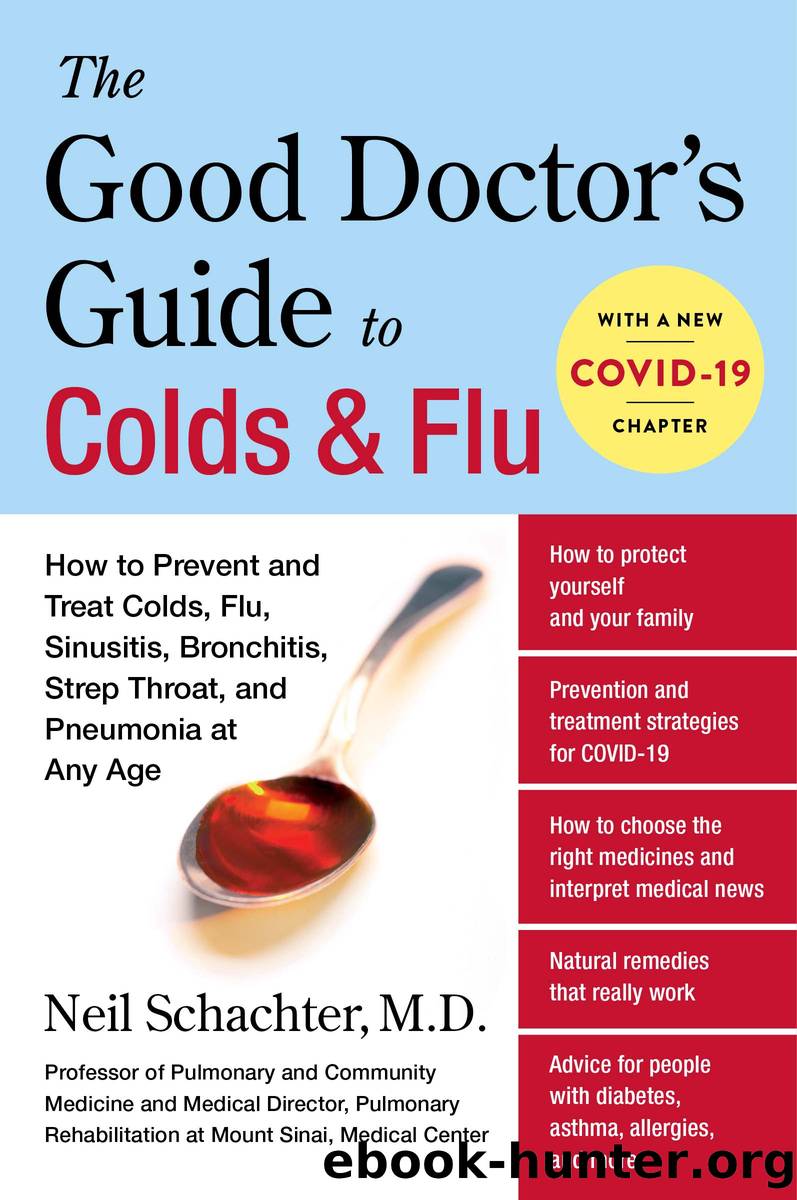The Good Doctor's Guide to Colds and Flu by Neil Schachter M.D

Author:Neil Schachter, M.D.
Language: eng
Format: epub
ISBN: 9780063094352
Publisher: Harper Paperbacks
Serious Treatment for a Serious Disease
According to the American Thoracic Society (ATS), 75 percent of people with pneumonia can safely and effectively be treated at home. To identify when hospitalization is needed, the ATS has developed a profile of key signs that suggest direct medical care is needed.
At the top of the list is mental status. This is not an IQ test, but a measure of whether a patient can understand how to manage the pneumonia at home. When I was a first-year resident at Bellevue, I hospitalized seventy-five-year-old Edna Poole for what looked like a fairly mild pneumonia. The chief resident was furious, pointing out that her fever was barely over 101 and she didnât even need oxygen. He wanted to discharge her immediately, but I insisted that we both examine her. He just rolled his eyes, so to sweeten the deal I proposed that if he was right, I would send her home and buy him dinner at Mugs, the nearby steak house. If I was right, Edna would stay in the hospital and the dinner was on him.
When we walked into her hospital room, she was sitting up nibbling on her lunch. I waited until she had finished eating, then moved the tray away to examine her. As I put the stethoscope to her chest, she raised her head and remarked, âI smell food. They will be serving lunch soon.â When I gently explained that she had just eaten lunch, she wasnât upset. âDid I enjoy it?â she asked cheerfully.
Edna stayed in the hospital for a week, and that night I had one of the best roast beef dinners I had ever eaten.
In addition to mental status, ATS guidelines suggest (either singly or in combination) that a pulse rate over 125 beats per minute (normal is 60â100), respiration rate over 20 (normal is 12â18), underlying health problems such as diabetes, and fever over 40°C (104°F) are signals that hospitalization is necessary.
One criteria for hospital care is so important that it actually stands alone. We measure the saturation of hemoglobin in the blood with oxygen (normally hemoglobin is at least 95 percent saturated with oxygen; when the level falls below 90 percent, this puts a strain on the heart and deprives tissues of needed oxygen). We use a machine called the pulse oximeter to measure this saturation. The âprobeâ is like a glove and slips around a finger, shining a light through the skin. This device is hooked up to a monitor that continuously displays the oxygen saturation level.
The reading gives the percentage of maximal oxygen levels. Anything from 95 to 100 percent is considered safe. Readings of 91 to 94 percent are a sign for concern. A reading of less than 90 percent or less is a sign that this pneumonia probably needs hospital care.
Once that decision is made, doctors have to judge if the patient needs to be admitted to the intensive care unit (ICU). This judgment is usually based on the patientâs need for the sophisticated respiratory support that is provided in intensive care.
Download
This site does not store any files on its server. We only index and link to content provided by other sites. Please contact the content providers to delete copyright contents if any and email us, we'll remove relevant links or contents immediately.
The DNA Book by DK(778)
The Spike by Mark Humphries;(769)
The End of Food Allergy by Kari Nadeau MD PhD & Sloan Barnett(687)
Extra Life by Steven Johnson(666)
Your Brain Is Always Listening by Dr. Daniel G. Amen(654)
How to Sleep by Rafael Pelayo(603)
Unlocking Eden: Revolutionize Your Health, Maximize Your Immunity, Restore Your Vitality by Belt Daniel & Horn Joe(594)
The Hashimoto's AIP Cookbook: Easy Recipes for Thyroid Healing on the Paleo Autoimmune Protocol by Emily Kyle MS RDN CLT HCP & Phil Kyle Chef(592)
The Hospital by Brian Alexander(590)
The Low-FODMAP IBS Solution Plan and Cookbook by Rachel Pauls(583)
The Covid Survival Guide: What the Virus Is, How to Avoid It, How to Survive It by Rowell David(566)
The Big Book of Baby Names by Marissa Charles(554)
Lymph & Longevity by Gerald Lemole(539)
Linda Goodman's Love Signs by Linda Goodman(522)
Better Living Through Neurochemistry - A guide to the optimization of serotonin, dopamine and the neurotransmitters that color your world by James Lee(515)
Thrivers by Michele Borba Ed. D(508)
The Miracle Pill by Peter Walker(503)
Stroke For Dummies by John R. Marler(492)
Immunity by Jenna Macciochi(487)
